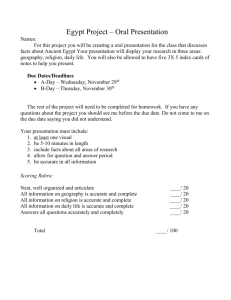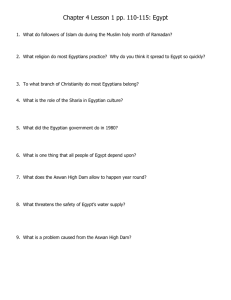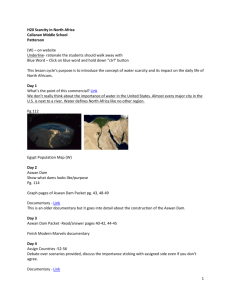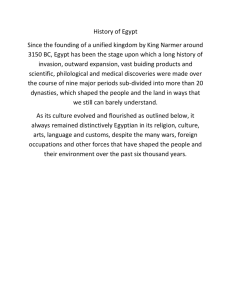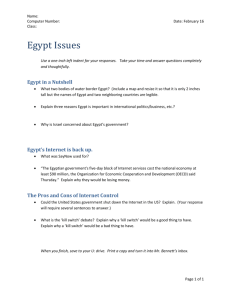Egypt lesson plan - World Affairs Council of Houston
advertisement
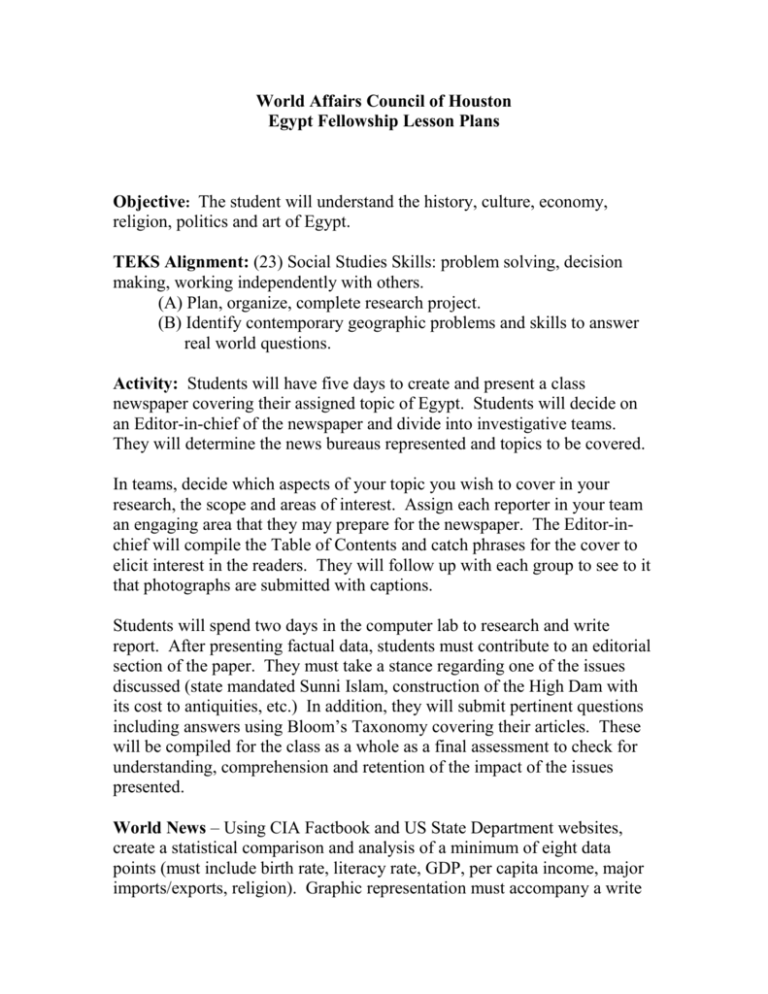
World Affairs Council of Houston Egypt Fellowship Lesson Plans Objective: The student will understand the history, culture, economy, religion, politics and art of Egypt. TEKS Alignment: (23) Social Studies Skills: problem solving, decision making, working independently with others. (A) Plan, organize, complete research project. (B) Identify contemporary geographic problems and skills to answer real world questions. Activity: Students will have five days to create and present a class newspaper covering their assigned topic of Egypt. Students will decide on an Editor-in-chief of the newspaper and divide into investigative teams. They will determine the news bureaus represented and topics to be covered. In teams, decide which aspects of your topic you wish to cover in your research, the scope and areas of interest. Assign each reporter in your team an engaging area that they may prepare for the newspaper. The Editor-inchief will compile the Table of Contents and catch phrases for the cover to elicit interest in the readers. They will follow up with each group to see to it that photographs are submitted with captions. Students will spend two days in the computer lab to research and write report. After presenting factual data, students must contribute to an editorial section of the paper. They must take a stance regarding one of the issues discussed (state mandated Sunni Islam, construction of the High Dam with its cost to antiquities, etc.) In addition, they will submit pertinent questions including answers using Bloom’s Taxonomy covering their articles. These will be compiled for the class as a whole as a final assessment to check for understanding, comprehension and retention of the impact of the issues presented. World News – Using CIA Factbook and US State Department websites, create a statistical comparison and analysis of a minimum of eight data points (must include birth rate, literacy rate, GDP, per capita income, major imports/exports, religion). Graphic representation must accompany a write of Egypt’s standing compared to that of four other African nations (students’ choice: one country from each of Africa’s four regions) and four other nations in the rest of the world (USA and China must be used; the other two are the students’ choice). TEKS: (7) Geography: the student understands growth, distribution, movement, and characteristics of world population (A) Construct and analyze data, graphics, maps, and characteristic of different societies National News – three part series of articles considering the pros and cons of constructing the Aswan High Dam First article will be written from the point of view of the construction company and the local farmers giving reasons for dam erection (include irrigation, trade, and fishing benefits along the Nile) Second article will be written from the point of view of archeologists, museum director, and the head of Egypt’s head of tourism department giving reasons to stop dam erection (include destruction of antiquities as well as human and animal habitats) Third article will be written from the point of view of the government agency making a final decision on the Aswan High Dam project. This article must offer a comparison between Egypt’s current situations with that of the Three Rivers Gorge Dam in China. Pros and Cons of China’s construction must be considered and elaborated in decision making process, including micro and macro management. TEKS: (5) Geography: the student understands how political, economic, and social processes shape cultural patterns and characteristics in various regions (A)Analyze how the character of a place is related to political, social, and geographic characteristics. Make connections among economic development, urbanization, population growth, and environmental change. (B) Compare ways humans depend on, adapt to, and modify physical environment (C) Describe the impact of and analyze the reaction of the environment to abnormal conditions (D) Analyze data to infer the effects of physical and human processes on patterns of settlement, economic and political conditions, and resource distribution Local News- Choose a city in Egypt and compare the life of the average male citizen to that of the average female citizen. Include daily responsibilities, duties in the home, jobs, position in the community and religious sector, level of education, as well as recreational and leisure activities. TEKS: (17) The student understands the distribution, patterns, and characteristics of different cultures (A) Describe and compare patterns of culture such as language, religion, and land use, systems of education, and customs that make specific regions of the world distinctive (B) Compare economic opportunities in different cultures for women in selected regions Historical Perspective – Students will construct a pictorial timeline featuring the major architectural and technological achievements during the reign of the Pharaohs. Each entry will be written up in terms of how the technology shaped the physical and cultural landscape, the work force (paid and slave labor), as well as Egypt’s worldwide contribution TEKS: (19) Science, technology and society. The student understands the impact of technology and human modification on the physical environment. (A) Evaluate the significance of major technological innovations and how they modified the physical environment (B) Analyze ways technological innovations have allowed humans to adapt to places shaped by processes such as floods (20) Science, technology, and society. The student understands how technology affects use of resources (B) Analyze the role to technology in agriculture and other primary activities and identify the environmental consequences of the changes that have taken place. Travel and Leisure – Students will create a section for tourists highlighting local and cultural events of note. This section must include two different week long travel plans for families arriving at Egypt’s bustling capital, Cairo, and in a rural Nubian village. Find transportation from the airport to sleeping quarters; locate restaurants, museums, historical landmarks, bazaar shopping, camel rides, and any other family friendly activities. Students must include monetary conversion charts and a local temperature graphs for monthly highs and lows in each of the three regions to better prepare the travelers. Students will complete the section with a comparative analysis of the two regions. TEKS: (9) Geography: the student understands the concept of region as an area of Earth’s surface with unifying geographic characteristics (B) Identify the differences among formal , functional, and perceptual regions Other possibilities include: Religion Section – Trace the spatial diffusion of Sunni Islam Entertainment News – may have crossword puzzle with definitions to vocabulary terms as clues and terms appearing as answers in the grid, various scrambles or word games, timeline to be completed, cartoons Sports Section – state sponsored, national pride s Political/Editorial Section – letters to the editor, op ed pieces, political cartoons
